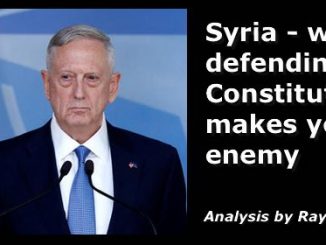
Poland to Waste Money on Useless Patriot SAM System: No Chance Against Russia’s Iskander
ANDREI AKULOV
US President Donald Trump’s visit to Warsaw will be remembered as the first stop on his second foreign trip used to showcase commitment to NATO and promote the shipments of American liquefied natural gas (LNG) to make Poland a hub for supplies entering Eastern Europe from overseas. It was also announced  with great pomp that the parties had signed a memorandum to sell Patriot air and missile defense systems. This is a deal worth up to $7.6 billion with US firm Raytheon to buy eight Patriots by the end of the current year. The first deliveries of the missile interceptors may take place within two years.
with great pomp that the parties had signed a memorandum to sell Patriot air and missile defense systems. This is a deal worth up to $7.6 billion with US firm Raytheon to buy eight Patriots by the end of the current year. The first deliveries of the missile interceptors may take place within two years.
The agreement is central to the Polish plans to implement a program of modernizing the military by 2023. The US also promised to help in creating a Polish national air defense system.
The Patriot PAC-3 missile segment enhancement (MSE) is a mobile long-range surface-to-air missile (SAM) system with ballistic missile defense (BMD) capability, including some intermediate range targets. It is considered to be the last line of defense. The PAC-3 version has been specifically designed to intercept and destroy missiles by impacting them directly with kinetic energy – «hit-to-kill» technology. The range of the missile is 70km and maximum altitude is greater than 24km. According to some sources, a PAC-3 MSE can go up to 35km. Radar range: 150+km with the capacity to track up to 100 targets and provide missile guidance data for up to nine missiles.
The minimum flight time is the time to arm the missile, which is less than nine seconds, and the maximum flight time is less than three and a half minutes. Aircraft kill probability: 0, 8-0, 9, tactical ballistic missile without jamming: 0, 6-0, 8. Maximum speed: 1600 m/s. Defended area against ballistic missiles: 15-20km.
The PAC-3 system can defend against ballistic missiles of all types; however, it is less effective against aircraft and air-to surface missiles. This is why it is deployed alongside the Patriot PAC-2 launchers with long-range missiles. The system fully depends on a satellite in orbit to provide it with data for guidance and that’s a shortcoming. The process takes 90 seconds, about 10 times more than in the case of the Russian S-400. Russian air defense missile systems are different from those of the United States, being less dependent on satellite data and having larger number of simultaneously engaged targets.
In a hypothetical military conflict, Patriot PAC-3 is unlikely to be able to cope with Russian Iskander tactical ballistic missiles, which are highly maneuverable, have a reduced radar signature and create interference. The US system is not designed to engage high speed maneuvering targets, while Iskander is designed specifically to evade both PAC-3 Patriot and THAAD.
The speed of Patriot PAC-3 is Mach 5.0 and maximum altitude is 35km or less. Iskander-M has a speed of speed Mach 6.7 with a range of 500km and 50km altitude. At the initial phase, the Russian missile flies almost vertically towards space like an intercontinental ballistic missile (ICBM) does. After reaching the highest point, Iskander moves towards its target while flying at the altitude to stay away from any air defense system. Reaching the target, the ballistic missile does a 90 degree turn and starts to maneuver on its final phase. So, it cannot be shot by a Patriot either at an early phase or in mid-course. The evasive trajectory of the final phase makes it almost impossible to hit. With Iskander, early warning and detection and time to target-intercept time becomes very short. Simply put, Iskander flies too fast and too high for a PAC-3 to catch it.
Besides, the Iskander can use decoys that have an identical radar signal. It makes interception almost unthinkable. The Patriot has no heat sensors and color matching seekers to give it a chance to differentiate the real target missile from a decoy. There is only a very slight probability that a single such missile could be destroyed during a real war.
PAC-3 is considered as an element of multi-layered defense. An Aegis Ashore long-range missile defense system site is being built in Poland. The next step will probably be adding another layer with THAAD, performing kinetic exoatmospheric interceptions at a distance of two hundred kilometers. With Aegis, THAAD and Patriot deployed on its soil, Poland will become a US global missile defense element located in Europe near Russia’s borders.
Taking into consideration the low kill probability of American systems, Warsaw will pay for the versions being constantly modernized. It will become a victim of arms race. And it does  not mean Poland will have the best. For instance, Turkey, a NATO member, has asked Russia to sell it S-400 BMD capable air defense systems (pictured). Moscow has said it is ready to sign the deal. Ankara has studied all the options thoroughly before making the choice.
not mean Poland will have the best. For instance, Turkey, a NATO member, has asked Russia to sell it S-400 BMD capable air defense systems (pictured). Moscow has said it is ready to sign the deal. Ankara has studied all the options thoroughly before making the choice.
Saudi Arabia, an old America ally, has also expressed its desire to purchase S-400s. There are many other countries in the world eyeing the cutting-edge system. It’s a generally accepted fact that S-400 has no analogue in the world. But Patriots have to be sold to create working places in the US in accordance with the «America First» principle.
Poland’s security will not be enhanced by joining the NATO ballistic missile defense. With the Aegis Ashore and Patriot systems stationed in Poland, the country will willy-nilly become a target for the Russian military. This is an example to show how easy it is to create threats and how much money and effort it takes to create a potential to defend against them, especially in view that no fully reliable system to counter ballistic and cruise missiles exists in the world. And Patriot is not number one among the BMD capable SAMs. Joining the US-led NATO BMD effort is like shooting itself in the foot. The only thing one gets is expenditure, dependence on other countries and undermined security.
During President Trump’s visit, Polish President Andrzej Duda said he wanted the US troops to be stationed permanently. The country already hosts 5,000 America servicemen based on «rotation basis» under the pretext of exercises. Poland is also one of only four NATO members other than the US that spends the 2 per cent target of GDP on defense. The country is to host the Aegis Ashore land-based component of the NATO BMD system. Aegis Ashore is to be deployed in 2018 as part of the Phased Adaptive Approach (PAA) Phase III. This technology will use Aegis BMD 5.1 and the SM-3 Block IB and IIA interceptors to cover northern Europe. Poland has also been a purchaser of US military equipment, including AGM-158B JASSM-ER (extended range) air-to-surface missiles to strike targets deep in Russian territory.
Warsaw has great ambitions. It strives to be an assertive power player in Europe. Poland wants American support at a time its relations with the EU are at all time low. The US can help. It needs devoted friends in Europe. According to The Washington Post, hundreds of thousands of Polish American voters live in states like Michigan, Ohio and Wisconsin, which will be key states in the 2020 election. The US is interested in arms deals and elements of its missile defense deployed in other countries.
But there is no such thing as free lunch. Warsaw will have to increase its defense expenditure and pay higher prices for US sea-transported LNG as the gas supplied via pipelines is cheaper. The country’s security will be reduced, not enhanced. The budget will take a severe blow. With America making gains, Poland has nothing to win.
************
ER recommends other articles by Strategic Culture Foundation
About the author
Andrei Akulov is a retired colonel and Moscow-based expert on international security issues




